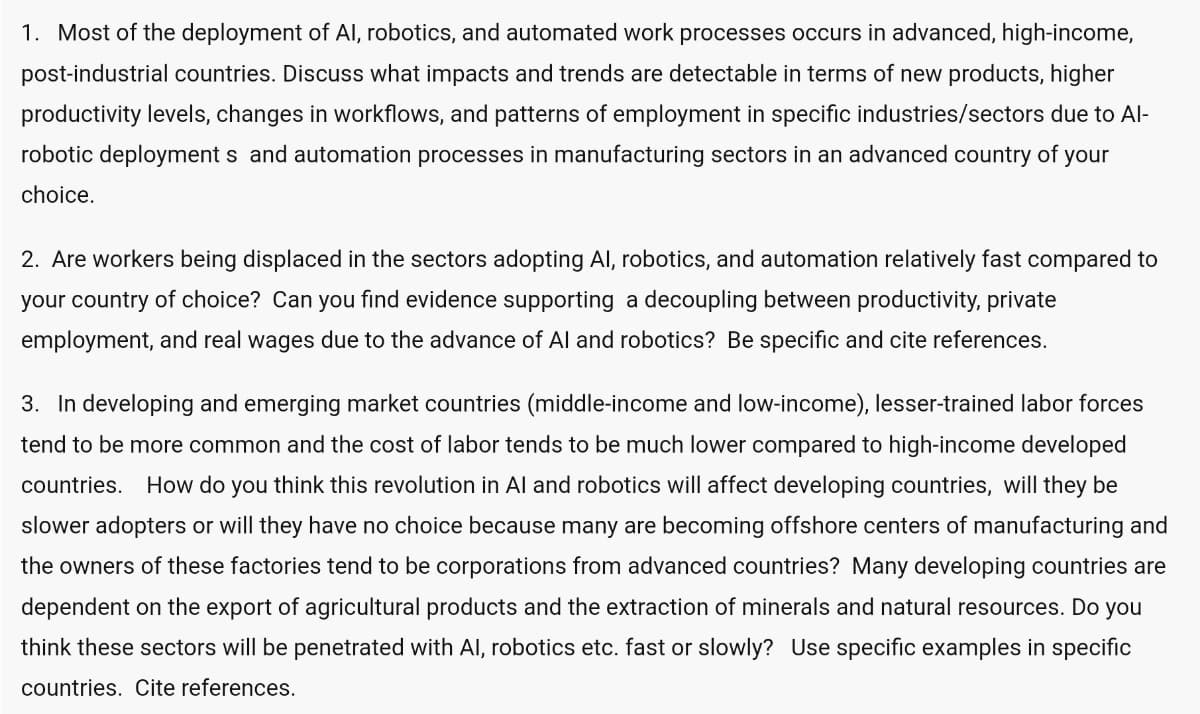Most of the deployment of Al, robotics, and automated work processes occurs in advanced, high-income, st-industrial countries. Discuss what impacts and trends are detectable in terms of new products, higher ductivity levels, changes in workflows, and patterns of employment in specific industries/sectors due to Al- potic deployment s and automation processes in manufacturing sectors in an advanced country of your bice. Are workers being displaced in the sectors adopting Al, robotics, and automation relatively fast compared to ur country of choice? Can you find evidence supporting a decoupling between productivity, private ployment, and real wages due to the advance of Al and robotics? Be specific and cite references. In developing and emerging market countries (middle-income and low-income), lesser-trained labor forces d to be more common and the cost of labor tends to be much lower compared to high-income developed untries. How do you think this revolution in Al and robotics will affect developing countries. will they be
Most of the deployment of Al, robotics, and automated work processes occurs in advanced, high-income, st-industrial countries. Discuss what impacts and trends are detectable in terms of new products, higher ductivity levels, changes in workflows, and patterns of employment in specific industries/sectors due to Al- potic deployment s and automation processes in manufacturing sectors in an advanced country of your bice. Are workers being displaced in the sectors adopting Al, robotics, and automation relatively fast compared to ur country of choice? Can you find evidence supporting a decoupling between productivity, private ployment, and real wages due to the advance of Al and robotics? Be specific and cite references. In developing and emerging market countries (middle-income and low-income), lesser-trained labor forces d to be more common and the cost of labor tends to be much lower compared to high-income developed untries. How do you think this revolution in Al and robotics will affect developing countries. will they be
Chapter1: Taking Risks And Making Profits Within The Dynamic Business Environment
Section: Chapter Questions
Problem 1CE
Related questions
Question
Please help me make a summary post to the heading and the questions.

Transcribed Image Text:Forum: Discussion Week 5: Growth and Innovation: Racing with
Machines or Racing Against Machines

Transcribed Image Text:1. Most of the deployment of Al, robotics, and automated work processes occurs in advanced, high-income,
post-industrial countries. Discuss what impacts and trends are detectable in terms of new products, higher
productivity levels, changes in workflows, and patterns of employment in specific industries/sectors due to Al-
robotic deployments and automation processes in manufacturing sectors in an advanced country of your
choice.
2. Are workers being displaced in the sectors adopting Al, robotics, and automation relatively fast compared to
your country of choice? Can you find evidence supporting a decoupling between productivity, private
employment, and real wages due to the advance of Al and robotics? Be specific and cite references.
3. In developing and emerging market countries (middle-income and low-income), lesser-trained labor forces
tend to be more common and the cost of labor tends to be much lower compared to high-income developed
countries. How do you think this revolution in Al and robotics will affect developing countries, will they be
slower adopters or will they have no choice because many are becoming offshore centers of manufacturing and
the owners of these factories tend to be corporations from advanced countries? Many developing countries are
dependent on the export of agricultural products and the extraction of minerals and natural resources. Do you
think these sectors will be penetrated with Al, robotics etc. fast or slowly? Use specific examples in specific
countries. Cite references.
Expert Solution
This question has been solved!
Explore an expertly crafted, step-by-step solution for a thorough understanding of key concepts.
This is a popular solution!
Trending now
This is a popular solution!
Step by step
Solved in 3 steps

Recommended textbooks for you

Understanding Business
Management
ISBN:
9781259929434
Author:
William Nickels
Publisher:
McGraw-Hill Education

Management (14th Edition)
Management
ISBN:
9780134527604
Author:
Stephen P. Robbins, Mary A. Coulter
Publisher:
PEARSON

Spreadsheet Modeling & Decision Analysis: A Pract…
Management
ISBN:
9781305947412
Author:
Cliff Ragsdale
Publisher:
Cengage Learning

Understanding Business
Management
ISBN:
9781259929434
Author:
William Nickels
Publisher:
McGraw-Hill Education

Management (14th Edition)
Management
ISBN:
9780134527604
Author:
Stephen P. Robbins, Mary A. Coulter
Publisher:
PEARSON

Spreadsheet Modeling & Decision Analysis: A Pract…
Management
ISBN:
9781305947412
Author:
Cliff Ragsdale
Publisher:
Cengage Learning

Management Information Systems: Managing The Digi…
Management
ISBN:
9780135191798
Author:
Kenneth C. Laudon, Jane P. Laudon
Publisher:
PEARSON

Business Essentials (12th Edition) (What's New in…
Management
ISBN:
9780134728391
Author:
Ronald J. Ebert, Ricky W. Griffin
Publisher:
PEARSON

Fundamentals of Management (10th Edition)
Management
ISBN:
9780134237473
Author:
Stephen P. Robbins, Mary A. Coulter, David A. De Cenzo
Publisher:
PEARSON